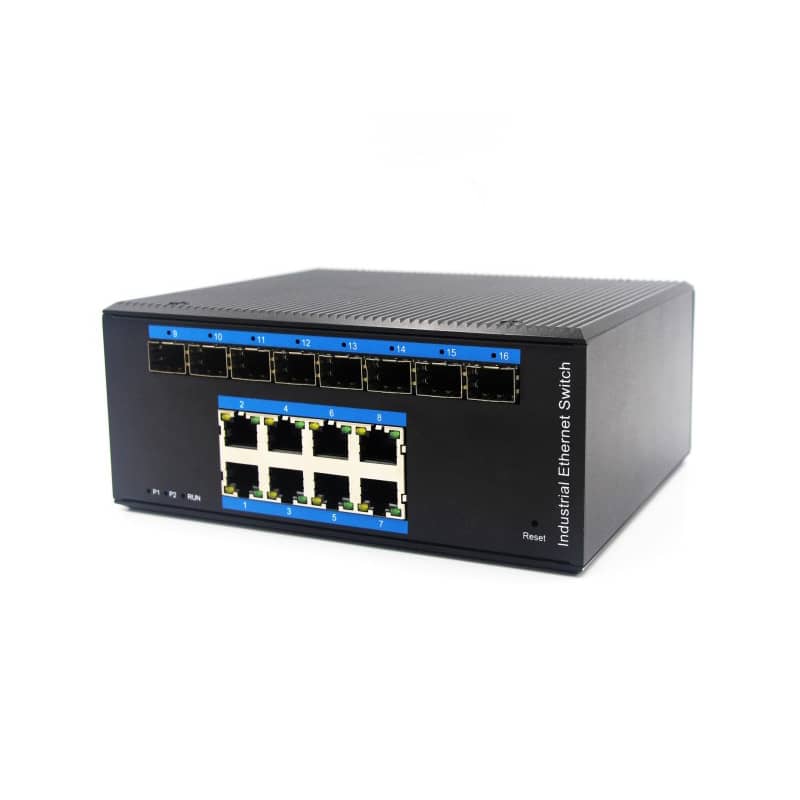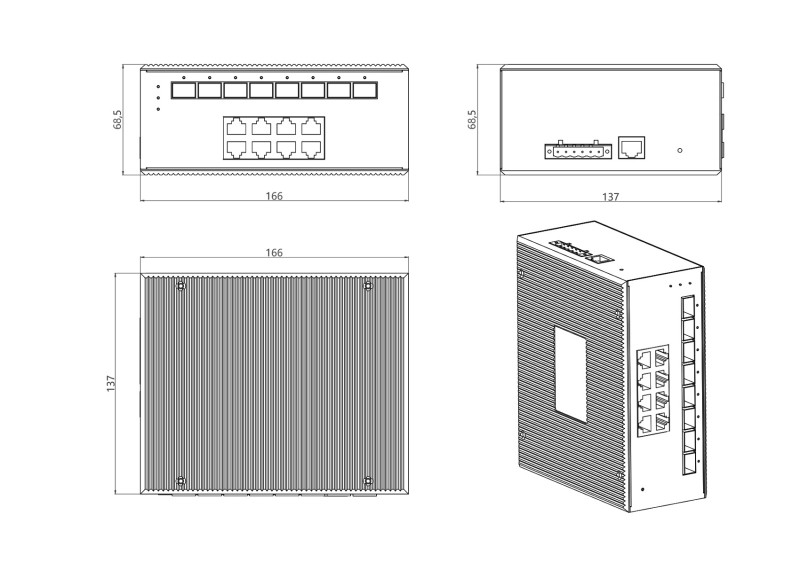.

In rapidly evolving industrial environments, a stable, intelligent, and power-efficient network backbone is critical. That’s where the 8-port L2+ industrial managed PoE switch becomes indispensable. Designed specifically for rugged deployments like factory floors, outdoor surveillance systems, and transportation networks, this type of switch combines Power over Ethernet (PoE) with advanced Layer 2+ network management features to simplify infrastructure and enhance performance.
Understanding the Role of an 8-Port PoE Switch in Industrial Networks
An 8 port PoE switch provides both data and electrical power through a single Ethernet cable, reducing the need for separate wiring. In industrial scenarios, this helps eliminate complex cabling layouts, especially when deploying IP cameras, access points, or sensors in difficult-to-reach areas.The 8-port configuration strikes a balance between cost-efficiency and scalability. It’s ideal for edge-level deployment in distributed networks, small control panels, or localized device clusters. In automation lines, for example, an 8-port switch can connect PLCs, sensors, and surveillance cameras with centralized management and real-time visibility.
What Makes It “L2+”?
The term L2+ PoE switch refers to a Layer 2 switch with certain Layer 3 capabilities, such as static routing, VLAN segmentation, DHCP snooping, IGMP snooping, and enhanced QoS. This makes L2+ switches smarter than basic unmanaged or L2-only switches, allowing for more advanced network control and traffic segmentation. For industrial uses, the benefits of L2+ switching are significant. It enables operators to isolate traffic between machine groups or departments, prioritize real-time data like video feeds, and maintain high security across distributed environments. For example, in a smart factory with dozens of machines and sensors, VLANs help ensure clean traffic flow while preventing cross-device interference.
Industrial Features That Matter
An industrial managed PoE switch is not the same as a commercial or office-grade switch. It’s built to operate in wide temperature ranges (e.g., -40°C to +75°C), withstand vibration and shock, and support DIN-rail mounting for control cabinets. Redundant power inputs and surge protection are also standard, ensuring 24/7 uptime in mission-critical systems.
Such switches are typically found in the following industries:
Manufacturing & Automation: For machine-to-machine communications, sensor networking, and HMI device connection.
Smart Cities: Connecting IP cameras, traffic control systems, and wireless APs at street level.
Energy & Utilities: In substations and remote monitoring setups with high environmental stress.
Transportation: In railway stations, tunnels, or roadways where robust and compact design is essential.
Why PoE with SFP Uplinks?
A PoE switch with SFP (Small Form-Factor Pluggable) ports provides added flexibility. While the regular RJ45 ports are used to power and connect IP devices, the SFP ports serve as high-speed fiber uplinks for long-distance transmission. In industrial settings, this ensures uninterrupted communication between remote cabinets or across large-scale plants. For example, if a control room needs to connect to another building 2km away, using a fiber SFP module eliminates the need for expensive long-range Ethernet cabling and ensures greater transmission integrity. The combination of PoE and SFP uplinks also helps build hierarchical network architectures where edge switches aggregate traffic to core switches or network video recorders (NVRs).
Centralized Control and Security with Managed PoE
The key advantage of an industrial managed PoE switch is control. Network administrators can remotely monitor each port, enable or disable power, assign bandwidth limits, and receive SNMP alerts in real time. This is especially important for industrial IoT applications where uptime and resource allocation need to be tightly regulated. Security features like port isolation, 802.1X authentication, ACLs, and MAC filtering further ensure that only authorized devices can access specific network zones. This is crucial in facilities where cybersecurity is as important as physical safety.

Practical Use Cases of an 8-Port L2+ Industrial PoE Switch
Let’s take a closer look at how this type of switch is used in real-world scenarios:
1. Factory Automation Network
A industrial managed PoE manufacturer installs a series of robotic arms and sensors across a production line. Each section has an 8 port PoE switch to power and connect devices. The L2+ features are used to create VLANs for machine groups, and SFP uplinks carry aggregated data back to the central server room.
2. Remote Surveillance for Oil Fields
Oilfield environments demand rugged networking hardware. Using an industrial managed PoE switch with SFP, operators can deploy IP cameras and edge analytics nodes miles apart while using fiber optics for reliable uplinks in harsh, EMI-prone conditions.
3. Smart Transportation System
In a smart highway monitoring setup, multiple 8-port switches are installed at traffic junctions. PoE powers road-side cameras and vehicle sensors, while SFP ports ensure seamless uplink to traffic management centers via underground fiber.

Benefits at a Glance
| Feature | Benefit |
|---|---|
| PoE Support | Reduces cabling and powers remote devices |
| L2+ Capabilities | Enables VLANs, static routing, and QoS |
| SFP Uplink | Supports long-distance, high-speed fiber connections |
| Industrial Design | Withstands harsh conditions and 24/7 operation |
| 8-Port Configuration | Ideal for localized edge deployments |
Final Thoughts:
In summary, an 8-port L2+ industrial managed PoE switch is an essential building block for intelligent, power-efficient, and secure industrial networks. Whether you’re deploying in a manufacturing plant, urban infrastructure, or energy facility, this switch offers the right mix of PoE flexibility, advanced traffic management, and rugged reliability. If your project requires scalable, fiber-ready networking with remote power delivery and real-time control, this type of switch is not just an option—it’s a necessity.





